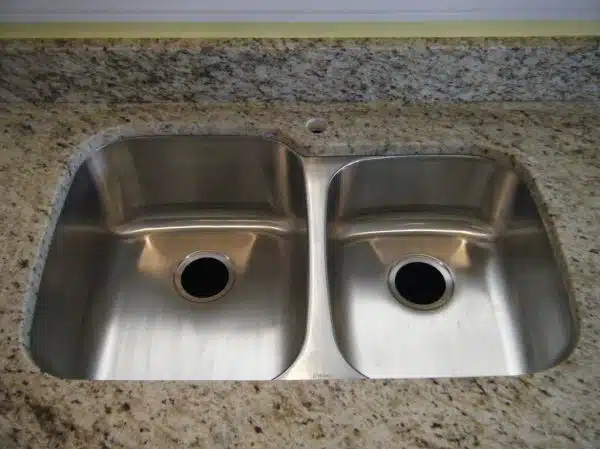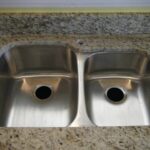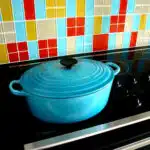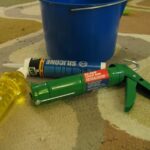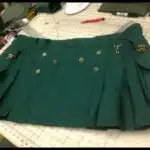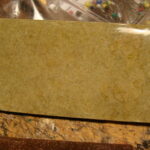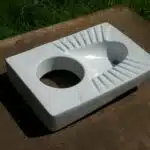Stainless steel is a popular material for appliances and kitchenware due to its durability, resistance to corrosion, and sleek appearance. However, over time stainless steel can become dull and tarnished due to fingerprints, grease, and other contaminants. As a stainless steel cleaning expert, I have developed effective techniques for restoring the shine of this material.
Cleaning stainless steel requires a delicate touch as aggressive cleaning products or abrasive materials can damage the surface. Understanding the properties of stainless steel is crucial when selecting the appropriate cleaning method. In this article, I will share my expertise on how to clean stainless steel effectively and safely without damaging its surface. By implementing these techniques, your stainless steel appliances and kitchenware will regain their lustrous shine, enhancing their aesthetic appeal and longevity.
Understanding Stainless Steel Properties
Stainless steel is a popular material used in different industries, including manufacturing, construction, and food processing. This type of metal is known for its corrosion resistance, which makes it an ideal choice for various applications. According to statistics, stainless steel accounts for approximately 20% of the world’s total steel production. Understanding the properties of stainless steel can help you maintain its shine and prolong its life.
One essential property of stainless steel is its corrosion resistance. This characteristic comes from the presence of chromium in the metal alloy, which forms a passive oxide layer on the surface that protects it from rust and other types of corrosion. The amount of chromium added to the mixture determines the level of protection provided by the stainless steel. Different grades of stainless steel have varying levels of resistance to different environments such as saltwater or acidic solutions.
Another factor that affects stainless steel’s properties is its composition. Stainless steel is made up of iron, carbon, and other elements such as nickel and molybdenum. The proportion and type of these elements determine the mechanical strength and hardness of the metal. For instance, austenitic stainless steels are non-magnetic and have excellent formability but lower strength compared to martensitic stainless steels that are magnetic but harder to shape.
Understanding corrosion resistance and different grades of stainless steel can help you choose the right cleaning method without damaging your equipment or utensils. To achieve a shiny appearance on your stainless-steel items, identifying their type is crucial in selecting appropriate cleaning agents and techniques that match their characteristics.
Identify The Type Of Stainless Steel
- Determining the grade of stainless steel is an important step when cleaning it. It is necessary to understand the type and grade of the material in order to choose the best cleaning method.
- Identifying the finish of stainless steel is also important. Depending on the finish, different cleaning methods may be needed.
- Differentiating between surface treatments is also crucial when cleaning stainless steel. For instance, some surfaces are more prone to scratches than others and require gentler cleaning methods.
- The most common grades of stainless steel are 304 and 316. Grade 304 is more susceptible to corrosion, but is cheaper, while Grade 316 is more resistant to corrosion, but is more expensive.
- Stainless steel finishes can be classified into three categories: mill, brushed, and polished finishes. Mill finishes are the most common, but brushed and polished finishes are also available.
- A variety of surface treatments are available to enhance the appearance of stainless steel. Common treatments include anodizing, electroplating, and painting.
Determining Grade
When it comes to cleaning stainless steel, identifying the type of steel is crucial. The first step in this process is determining the grade of your stainless steel. Stainless steel grading standards were established by the American Iron and Steel Institute (AISI) to classify different types of stainless steel based on their compositions. These grades range from 200 series to 900 series, each with different properties and uses.
One important factor to consider when determining grade is corrosion resistance. Stainless steel contains chromium which forms a passive layer on the surface, protecting it from corrosion. The amount of chromium present determines its resistance to corrosion and thus its grade. Grades 300 and above have higher amounts of chromium, making them more resistant to corrosion than lower grades like 200 series.
To determine the exact grade of your stainless steel, you can use various methods such as spark testing or chemical analysis. While these methods may require specialized equipment and expertise, simply checking for a label or stamp on the product can also give you an idea of its grade. By knowing your stainless steel’s grade and level of corrosion resistance, you can choose the appropriate cleaning method that will effectively remove dirt and grime while maintaining its shine and durability.
Identifying Finish
As a stainless steel cleaning expert, identifying the type of steel is crucial in determining the appropriate cleaning method. Aside from knowing the grade and level of corrosion resistance, identifying the finish of your stainless steel is also important. Differentiating between brushed and polished finishes can help you determine which is easier to clean.
Brushed finishes are created by using abrasive materials on the surface of the steel, resulting in a textured matte appearance. This finish is commonly used for appliances, sinks, and countertops as it hides fingerprints and scratches well. On the other hand, polished finishes have a smooth and shiny appearance that resembles a mirror. This finish is often used for decorative purposes such as handrails or trim work.
When it comes to cleaning these finishes, brushed stainless steel is generally easier to maintain than polished stainless steel. Its texture helps hide minor scratches and fingerprints, making it less prone to showing signs of wear and tear. However, polishing products specifically designed for stainless steel can effectively remove stains and restore shine without damaging either finish. Understanding the type of finish on your stainless steel will help you choose an appropriate cleaning method that will keep your appliance looking brand new for years to come.
Differentiating Surface Treatments
As a stainless steel cleaning expert, it is important to identify the type of stainless steel in order to determine the appropriate cleaning method. Corrosion resistance and durability are key properties to consider. However, understanding the surface treatment of your stainless steel is just as crucial. There are two main types of surface treatments: chemical and mechanical.
Chemical surface treatments involve applying a thin layer of chemicals onto the stainless steel to change its appearance or improve its performance. These treatments include passivation, pickling, and electro-polishing. Passivation involves immersing the steel in an acidic solution to remove any impurities on the surface that can cause rusting or corrosion. Pickling involves removing any oxide scales from heat treating or welding by dipping the steel into an acid bath. Electro-polishing uses an electrical current to dissolve a thin layer of metal from the surface, resulting in a smooth and shiny finish.
On the other hand, mechanical surface treatments involve using abrasives or mechanical processes to alter the appearance or performance of stainless steel. These treatments include blasting, grinding, brushing, and polishing. Blasting involves shooting abrasive materials at high speed onto the surface of the steel to create a textured finish. Grinding uses abrasive discs or belts to remove imperfections on the surface of the steel and create a smooth finish. Brushing involves using abrasive pads or wire brushes to create a matte finish with visible lines or ridges while polishing creates a mirror-like shine.
Differentiating between chemical and mechanical surface treatments can help you choose the right cleaning method for your stainless steel appliance depending on its texture and level of corrosion resistance. While chemical treatments offer superior resistance against rust and corrosion, they may also be more difficult to clean due to their smooth surfaces. Mechanical finishes may be easier to clean but require regular maintenance due to their textured finishes that can trap dirt and grime over time. Understanding these pros and cons will help you keep your appliances looking brand new for years to come.
Gather Necessary Cleaning Supplies
Selecting the Right Cleaning Supplies is crucial to achieving a sparkling clean stainless steel surface. First and foremost, make sure you have a microfiber cloth or soft sponge handy. These materials are gentle enough to not scratch the stainless steel but are still effective in removing dirt and grime. Avoid using abrasive sponges or brushes that can damage the surface.
Next, choose a cleaning solution that is specifically designed for stainless steel surfaces. Avoid using acidic or bleach-based cleaners as they can cause discoloration and corrosion of the surface. Instead, opt for neutral pH cleaners that are safe for stainless steel and won’t leave any residue.
Tips for Organizing Your Cleaning Supplies: Keep all your cleaning supplies in one place to make your cleaning routine more efficient. This can be a designated cupboard or shelf in your kitchen or cleaning closet. Use labeled containers to keep everything organized and easily accessible. Always check expiration dates on your cleaning products before use, as expired products may not work effectively.
With the right tools in hand, you’re ready to move on to preparing the surface for cleaning. Start by wiping down the surface with warm soapy water to remove any loose debris or grease buildup. Rinse thoroughly with clean water and then dry with a soft cloth to avoid water spots.
Preparing The Surface For Cleaning
Understanding the properties of stainless steel is crucial in preparing the surface for cleaning. Stainless steel is a durable and corrosion-resistant material that contains chromium, which reacts with oxygen to form a thin protective layer on its surface. This layer prevents rust and tarnishing but can be damaged by harsh chemicals or abrasive materials.
Choosing the right cleaning supplies is essential to maintain the integrity of stainless steel surfaces. Avoid using bleach, ammonia, or chlorine-based cleaners as they can damage the protective layer and cause discoloration. Instead, opt for mild detergents or specialized stainless steel cleaners that are pH balanced and non-abrasive. Microfiber cloths are also effective in gently removing dirt and grime without scratching the surface.
Proper preparation of the surface before cleaning ensures a successful outcome. With a basic understanding of stainless steel properties and careful selection of cleaning supplies, you can effectively remove dirt and grime from your stainless steel surfaces while preserving their shine and durability. In the next section, we will discuss how to clean stainless steel with soap and water, an easy yet effective method that requires minimal effort.
Cleaning Stainless Steel With Soap And Water
After having prepared the surface of your stainless steel, the next step is to clean it with soap and water. This is a simple and effective way to remove any dirt or grime that may have accumulated on the surface. However, it is important to get it right in order to avoid damaging the stainless steel.
One of the benefits of using soap when cleaning stainless steel is that it is effective in removing stubborn stains. The soap breaks down any grease or oil on the surface, making it easier to wipe away. Additionally, using soap helps to prevent streaks and water marks from forming on the stainless steel after cleaning.
However, there are common mistakes that people make when cleaning with soap. One such mistake is using an abrasive sponge or cloth which can scratch the surface of the stainless steel. Another mistake is leaving soap residue behind after cleaning, which can lead to streaking and water marks. To avoid these mistakes, use a soft sponge or microfiber cloth and rinse thoroughly after cleaning.
Transition: While soap and water can effectively clean stainless steel, there are other methods that can be used for more stubborn stains or for a deeper clean. One such method involves using vinegar as a natural cleaner for your stainless steel surfaces.
Using Vinegar To Clean Stainless Steel
Stainless steel is like a mirror that reflects the beauty of your kitchen. However, when not cleaned properly, it can lose its shine and look dull. Cleaning stainless steel may seem like a daunting task but with the right techniques, it can be an easy job. One such technique is using vinegar to clean stainless steel.
Using vinegar for stainless steel maintenance has been proven to be effective and efficient. Vinegar is a natural cleaning solution that not only helps in removing stains but also disinfects surfaces. It is a cost-effective option compared to other chemical solutions and does not harm the environment.
To use vinegar for cleaning stainless steel, you will need a few items such as a spray bottle, white vinegar, and a microfiber cloth. Here are some tips on how to use vinegar effectively:
- In a spray bottle, mix equal parts of water and white vinegar.
- Sub-list:
- The water should be distilled or filtered to avoid leaving mineral deposits on the surface.
- Use white vinegar instead of other types like apple cider or balsamic since they may leave stains.
- Spray the mixture onto the surface you want to clean and let it sit for 5-10 minutes.
- Sub-list:
- Do not spray too much as excess liquid may cause streaks.
- If there are tough stains, place a paper towel soaked in vinegar over the area for 10 minutes before wiping it off.
In summary, using natural cleaning solutions such as vinegar can have significant benefits for maintaining your stainless steel appliances’ shine without harming the environment or breaking your budget. In the next section, we will discuss another natural solution that can help remove tough stains from your stainless steel surfaces – applying baking soda.
Applying Baking Soda For Tough Stains
When it comes to tough stains on stainless steel, baking soda is a great natural alternative to chemical cleaners. Simply mix a small amount of baking soda with water to create a paste, then apply it to the affected area using a soft cloth or sponge. Gently rub the paste into the stain, using circular motions, until it begins to lift away.
While baking soda is an effective solution for tough stains on stainless steel, there are some alternatives that you can consider. For example, white vinegar and lemon juice can also be used as natural cleaning agents. However, it’s important to note that these products may not be suitable for all surfaces, so always check before using them.
It’s worth noting that you can also use baking soda on other surfaces in your home, such as tile grout and bathroom fixtures. However, it’s important to make sure that you’re not using too much pressure or scrubbing too hard when cleaning these surfaces with baking soda, as this could cause damage over time.
Transition: Now that we’ve covered how to use baking soda for tough stains on stainless steel, let’s move on to removing grease and fingerprints from your appliances.
Removing Grease And Fingerprints
When it comes to stainless steel, grease and fingerprints are the bane of their existence. These pesky culprits can make your once shiny appliance look dull and unappealing. But fear not! There are easy ways to remove these unwanted marks from your stainless steel surfaces.
Using household items such as vinegar or baking soda can be effective in removing grease and fingerprints from stainless steel. Simply mix equal parts water and vinegar or create a paste with baking soda and water. Apply the solution to a microfiber cloth and gently rub in a circular motion on the affected area. Rinse with warm water and dry with a clean cloth.
Preventing future buildup is also key in maintaining the shine of your stainless steel appliances. Avoid using abrasive cleaners or scrubbers which can scratch the surface, making it easier for grease and fingerprints to stick. Instead, opt for gentle cleaning solutions specifically designed for stainless steel surfaces. Regularly wiping down your appliances with a microfiber cloth after each use can also help prevent buildup.
Transitioning into the subsequent section about cleaning stainless steel appliances, it’s important to note that regular cleaning is essential in maintaining the beauty of your stainless steel surfaces. In the next section, we’ll explore various techniques for effectively cleaning all types of stainless steel appliances in your home.
Cleaning Stainless Steel Appliances
Stainless steel appliances are a popular choice for homeowners due to their sleek and modern appearance. However, over time, these appliances can lose their shine and become dull. Cleaning stainless steel appliances is essential to maintain their luster and keep them looking new.
To clean stainless steel appliances, start with a soft cloth or sponge and warm water. Gently wipe down the surface, being careful not to scrub too hard as this can cause scratches. For tougher stains or residue, use a mild detergent diluted in water. Rinse the appliance thoroughly with clean water and dry with a soft cloth.
Preventing corrosion and protecting against scratches are crucial steps in maintaining the appearance of stainless steel appliances. One way to prevent corrosion is by avoiding contact with other metals, such as iron or copper. Scratches can be prevented by using non-abrasive cleaners and avoiding harsh chemicals.
In the next section, we will discuss how to polish stainless steel to restore its shine and remove any remaining stains or marks that were not removed during cleaning. By following these cleaning tips and taking preventive measures against damage, your stainless steel appliances can maintain their beauty for years to come.
Polishing Stainless Steel
As a stainless steel cleaning expert, I understand how crucial it is to achieve a polished finish on stainless steel. A sparkling and shiny surface can give the appearance of brand new appliances, utensils, and other stainless steel items. To begin with, one can use symbolism to describe the process of polishing stainless steel. Think of the metal as a blank canvas that requires a lot of effort to create a work of art. With appropriate techniques, anyone can achieve an impressive finish.
If you are looking for DIY polishing techniques for your stainless steel items at home, there are several options available. One popular method is using baking soda and water to create a paste that is then applied to the surface with a soft cloth or sponge. Another effective option is vinegar and olive oil mixed together in equal parts and applied with a clean cloth. These methods may require some elbow grease but are extremely cost-effective.
For those who prefer professional polishing services, there are plenty of companies that specialize in restoring stainless steel surfaces to their original shine. However, it is essential to research the company before hiring them as not all services deliver high-quality results. Always check reviews from previous customers and ensure they have experience working with stainless steel.
To ensure you don’t damage your newly polished stainless steel surface, it’s important to know what materials you should avoid using when cleaning it. In the subsequent section about avoiding damage to stainless steel, we will discuss which household cleaners and tools you should steer clear from when maintaining your polished surface.
Avoiding Damage To Stainless Steel
When cleaning stainless steel, the choice of cleaning agents is important. Chemical cleaners can remove dirt and debris, but must be used with caution to ensure that the surface of the steel is not damaged. Natural or mild abrasive materials, such as baking soda and vinegar, can also be used to clean stainless steel without risking damage. For deeper cleaning, a soft cloth or sponge and gentle scrubbing is recommended.
Cleaning Agents
Have you ever been frustrated with the appearance of your stainless steel appliances? Perhaps they are covered in fingerprints or have lost their shine over time. Fortunately, cleaning stainless steel is a simple task when done correctly. When it comes to cleaning agents, there are many options available depending on your preferences and needs.
Firstly, many commercial stainless steel cleaners contain harsh chemicals that can damage both the appliance and the environment. However, there are also eco-friendly options available that work just as effectively. Vinegar and baking soda are two popular natural cleaning agents that can be used to clean stainless steel. Simply mix equal parts vinegar and water in a spray bottle or create a paste with baking soda and water. Apply the solution to a soft cloth and gently wipe down the appliance.
Secondly, if you prefer to use commercial cleaning products, be sure to read the label carefully before purchasing. Look for cleaning agents that specifically state they are safe for use on stainless steel appliances. Avoid any products containing chlorine bleach or ammonia as these chemicals can cause discoloration or even corrosion over time.
In conclusion, when it comes to keeping your stainless steel appliances looking their best, choosing the right cleaning agent is key. Whether you opt for natural remedies or commercial products, always make sure they are safe for use on stainless steel and avoid harsh chemicals whenever possible. With just a little bit of effort and care, you can keep your appliances shining like new for years to come!
Scrubbing Materials
As a stainless steel cleaning expert, it is crucial to emphasize that proper scrubbing tools must be chosen to avoid scratches on stainless steel surfaces. When it comes to cleaning stainless steel, the wrong scrubbing tool can cause permanent damage, resulting in a dull and unsightly appearance. Therefore, selecting an appropriate scrubbing tool is just as important as choosing the right cleaning agent.
When choosing a scrubbing tool for stainless steel appliances, it is best to opt for soft and non-abrasive materials such as microfiber cloths or soft-bristled brushes. Avoid using steel wool or rough sponges as they can leave deep scratches on the surface of the appliance. Always test the scrubbing tool on an inconspicuous area first before proceeding with cleaning the entire surface.
In addition to choosing appropriate scrubbing tools, it’s essential to use gentle pressure when cleaning stainless steel surfaces. Applying excessive force may cause scratches and harm the finish of your appliances. By following these simple guidelines and taking care not to damage your appliances’ surfaces, you can enjoy clean and shiny stainless steel appliances for years to come.
Maintaining The Shine Of Stainless Steel
Cleaning stainless steel is not just about removing dirt and grime, but also about preventing corrosion and maintaining its shine. Once you have successfully cleaned your stainless steel surface, it is important to know how to keep it looking shiny for longer periods. Here are some tips on how to maintain the shine of stainless steel.
Firstly, make sure to avoid abrasive cleaners and harsh chemicals that can damage your stainless steel surface. Instead, opt for gentle cleaning agents such as vinegar or dish soap mixed with warm water. You can also use a microfiber cloth or sponge to wipe down the surface in the direction of the grain. This will help prevent scratches and preserve the shine.
Secondly, buffing techniques can be used to enhance the shine of your stainless steel surface. One technique involves using a soft cloth or chamois that has been dampened with water and then wrung out until it is only slightly wet. Then, buff the surface in circular motions until it shines. Another method involves using a polishing compound specifically designed for stainless steel. Apply a small amount of this compound onto a soft cloth and gently rub onto the surface until it shines.
In conclusion, maintaining the shine of stainless steel requires both proper cleaning techniques and careful preservation methods such as avoiding harsh chemicals and utilizing buffing techniques. By following these tips, you can ensure that your stainless steel surfaces remain shiny and free from corrosion for years to come.
Transition: While these tips are effective in keeping your stainless steel shining bright, there are alternative cleaning methods that may suit your needs better depending on your specific situation.
Alternative Cleaning Methods
Lemon and vinegar are two common household items that can be used to clean stainless steel and help make it shine. Baking soda and vinegar can also be used, but should be mixed together to create a paste-like consistency before being applied to the stainless steel surface. This paste should be left on the surface for a few minutes before being wiped away. Additionally, it is important to note that using a soft cloth to apply the paste and buff afterwards is the best way to ensure that the stainless steel is properly cleaned and shined.
Lemon & Vinegar
When it comes to cleaning stainless steel, using natural cleaning solutions can be a great option. One effective alternative cleaning method is using lemon and vinegar to clean stainless steel. Both of these ingredients are readily available in most households and have natural acidic properties that make them effective at removing stains, grime, and water spots from stainless steel surfaces.
To use lemon and vinegar to clean stainless steel, start by mixing equal parts of both ingredients together in a spray bottle. Spray the solution onto the surface you want to clean and let it sit for a few minutes. Then, use a soft cloth or sponge to wipe away the solution and any dirt or stains on the surface. Rinse with warm water and dry with a clean towel.
It’s important to note that while lemon and vinegar are safe for use on most stainless steel surfaces, they should not be used on surfaces that are coated or painted as they could cause damage. Additionally, it’s always a good idea to test a small area first before applying the solution to the entire surface. By using this natural cleaning solution, you can make your stainless steel shine without harming the environment or exposing yourself to harsh chemicals.
Baking Soda & Vinegar
As a stainless steel cleaning expert, I highly recommend considering the benefits of using baking soda and vinegar as an alternative cleaning method. This natural cleaning solution is not only effective in removing tough stains and grime from stainless steel surfaces but is also environmentally friendly and safe for use around children and pets.
One technique for using baking soda and vinegar to clean stainless steel is to mix a paste using equal parts of both ingredients. Apply this paste onto the surface you want to clean, let it sit for a few minutes, then scrub with a soft cloth or sponge. Rinse with warm water and dry with a clean towel. Another technique is to pour vinegar onto the surface and sprinkle baking soda over it. This will cause a chemical reaction that helps loosen dirt and grime from the surface.
The benefits of baking soda & vinegar cleaning are numerous, including being affordable and accessible as these ingredients are readily available in most households. Additionally, this natural cleaning solution does not contain harsh chemicals that can harm your health or damage your stainless steel surfaces. By incorporating these vinegar and baking soda cleaning techniques into your routine, you can make your stainless steel surfaces shine while doing good for the environment.
Tips For Long-Term Maintenance
As the age-old adage goes, prevention is better than cure. This holds true for stainless steel maintenance as well. The first and foremost tip for long-term maintenance of stainless steel is to prevent scratches. Scratches on the surface of stainless steel can be caused by anything from abrasive cleaning materials to simply stacking cookware without proper padding in between. These scratches not only mar the appearance of the metal but also make it more prone to rusting.
To avoid harsh chemicals, one should steer clear of abrasive cleaners like bleach or scouring pads that can damage the surface of stainless steel. Instead, opt for gentler cleaning agents like mild soap solutions or specialized stainless steel cleaners available in the market. It is important to remember that even when using mild cleaning agents, one should always rinse thoroughly with water and dry with a soft cloth to prevent water spots.
Taking care of your stainless steel appliances and fixtures requires a little effort, but it goes a long way in maintaining their shine and durability over time. By following these simple tips and being mindful of how you use and clean your stainless steel items, you can ensure that they continue to look their best for years to come.
Moving on to frequently asked questions (FAQs), many people wonder if it’s safe to use vinegar or lemon juice as natural cleaning agents on stainless steel. Stay tuned for the next section where we will delve deeper into this topic and provide answers to some commonly asked questions about maintaining stainless steel items.
Frequently Asked Questions (Faqs
Maintaining the shine on stainless steel requires a few key steps that can make all the difference in keeping your appliances and surfaces looking their best. While there are several common misconceptions surrounding stainless steel cleaning, following the right techniques can help you achieve a sparkling finish.
First and foremost, it’s important to choose the best cleaning tools for the job. Avoid using abrasive or harsh chemicals that can scratch or damage your stainless steel surfaces. Instead, opt for gentle cleaners such as dish soap mixed with warm water, or specialized stainless steel cleaners. Microfiber cloths are also an excellent choice for wiping down surfaces without leaving behind unsightly streaks or scratches.
Another important step in keeping your stainless steel shining is to be consistent with your cleaning routine. Regularly wiping down surfaces with a damp cloth and drying them thoroughly can prevent dirt and grime from building up over time. Additionally, avoid leaving spills or stains on your stainless steel for extended periods of time, as they can cause discoloration or damage.
In summary, maintaining a shiny finish on stainless steel requires careful attention to detail and a commitment to using the best cleaning tools available. By following these tips and avoiding common misconceptions about stainless steel care, you can keep your appliances and surfaces looking their best for years to come.
Conclusion
After understanding the properties of stainless steel and identifying the type of steel you are dealing with, cleaning it to make it shine requires a few necessary steps. Gathering the right cleaning supplies is crucial, as well as preparing the surface for cleaning by removing any debris or dirt. Soap and water can be used to clean stainless steel effectively, but maintaining its shine requires proper care and maintenance.
Alternative cleaning methods such as vinegar or lemon juice can also be used, but should be tested on a small area first before applying to the entire surface. Long-term maintenance tips include avoiding abrasive cleaners and using microfiber cloths to prevent scratching. As a stainless steel cleaning expert, it’s important to educate others on the proper techniques for achieving a flawless shine on their stainless steel surfaces.
In conclusion, maintaining the shine of stainless steel requires attention to detail and regular upkeep. With the right tools and techniques, anyone can achieve a sparkling finish on their stainless steel surfaces. Remember that prevention is key, so avoid using harsh chemicals or abrasive materials that could damage your precious metal. Follow these simple steps for keeping your stainless steel looking brand new for years to come!
Image Credits
- “Stainless Steel Undermount Sink” by granite-charlotte (featured)

